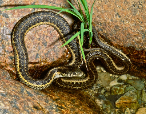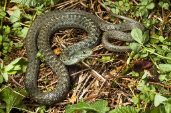Oregon Aquatic Garter Snake (T.a. hydrophilus)
Description: Adults are 18 - 40 inches long. Most snakes encountered are generally 18 - 28 inches long. Neonates are 7 - 10 inches. A medium-sized slender snake with a head barely wider than the neck and keeled dorsal scales. Some average scale counts: Average of 8 upper labial scales, 6 and 7 not enlarged. 11 lower labial scales. Rear pair of chin shields is longer than the front. The internasals are longer than they are wide and pointed in front. Average of 19 or 21 scales at mid-body. Ground color is gray, olive-gray, or brownish. This snake may have a light stripe on the back and a light stripe along the lower part of each side. The dorsal stripe and the side stripes may be absent or obscured, not contrasting sharply with the ground color, leaving a checkered appearance instead of striped. There are usually alternating dark spots on the sides. The throat is light in color. The underside is light and unmarked with a pinkish or purplish tint toward the tail.
Habitat: Creeks, streams, rivers, small lakes and ponds, in woodland, brush and forest. Seems to prefer shallow rocky creeks and streams.
Range: This subspecies, Thamnophis atratus hydrophilis - Oregon Aquatic Garter snake, ranges from northern Sonoma County north along the coast to Douglas County, Oregon, and east throughout the north coast ranges and to the lower Pit River area. It is absent from much of the coast around Humboldt County.
Found in these States:
CA |
OR
Diet: Probably eats mainly amphibians and their larvae, including frogs, tadpoles, and aquatic salamander larvae (newts and giant salamanders, Taricha and Dicamptodon ), but small fish are also eaten. Captives have also taken small rodents. Leeches may also be consumed - I saw a recently-captured T. a. zaxanthus regurgitate two leeches.
Reproduction: Courtship has been observed during March and April.
Females are ovoviviparous - they carry the eggs internally until the young are born live from late summer to early fall.
Status: Listed as Least Concern in view of its wide distribution, presumed large population, and because it is unlikely to be declining fast enough to qualify for listing in a more threatened category.
»» Kingdom: Animalia - Animals
»» Phylum: Chordata - Chordates
»» Subphylum: Vertebrata - Vertebrates
»» Class: Reptilia - Reptiles
»» Order: Squamata - Scaled Reptiles
»» Suborder: Serpentes
»» Superfamily: Colubroidea
»» Family: Colubridae - Colubrids
»» Genus: Thamnophis
»» Species: Thamnophis atratus - Aquatic Garter Snakes
»» Subspecies: T. a. hydrophilus - Oregon Aquatic Garter Snake
This article uses material from the Wikipedia article "Aquatic Garter Snakes", which is released under the Creative Commons Attribution-Share-Alike License 3.0. Content may have been omitted from the original, but no content has been changed or extended.
|








